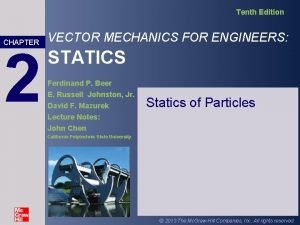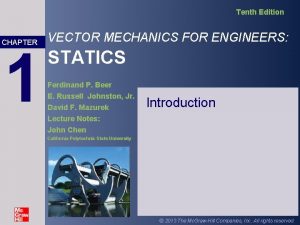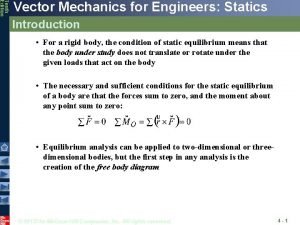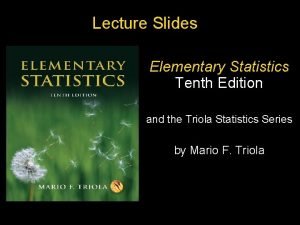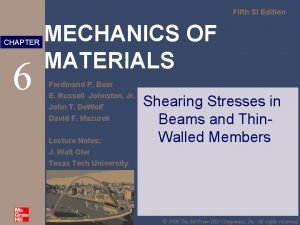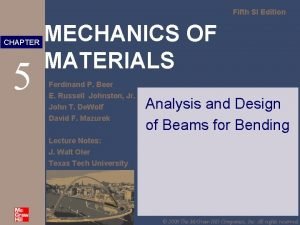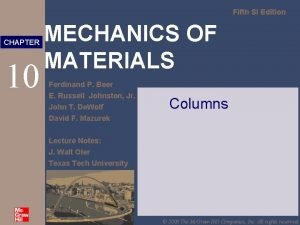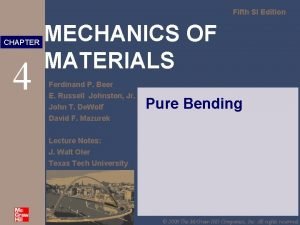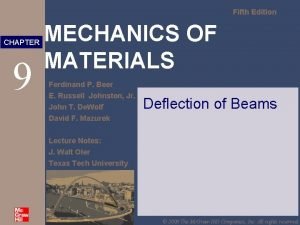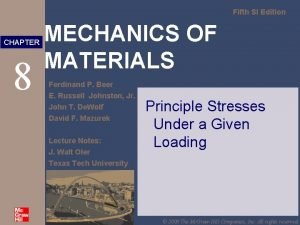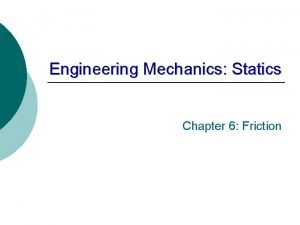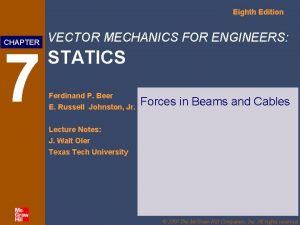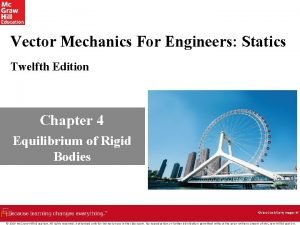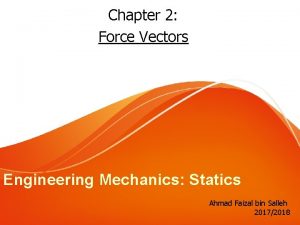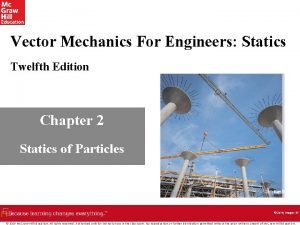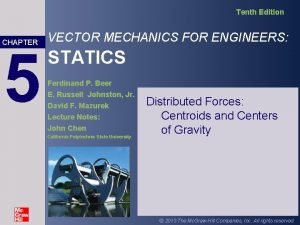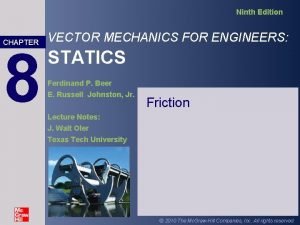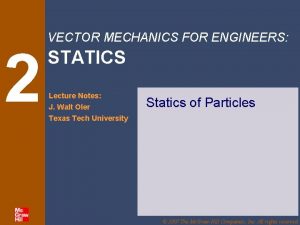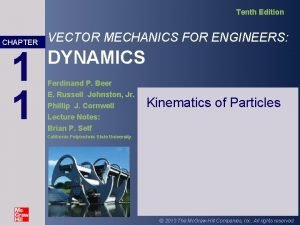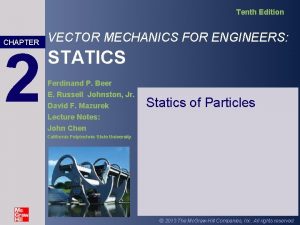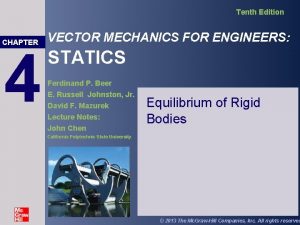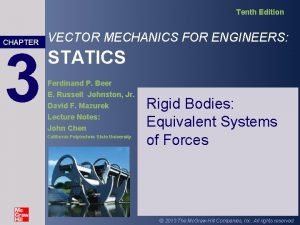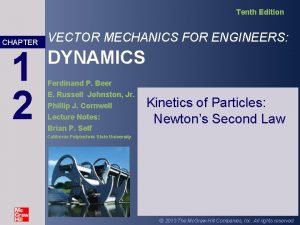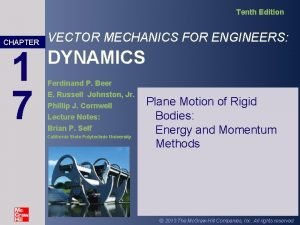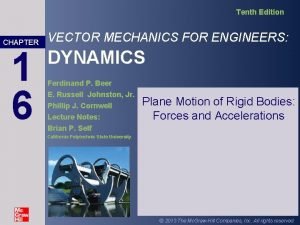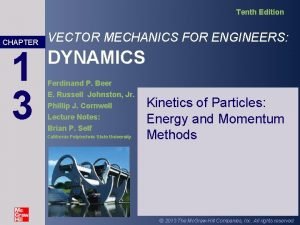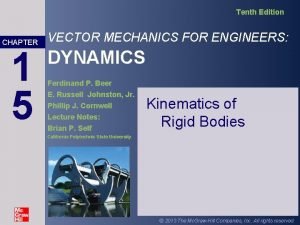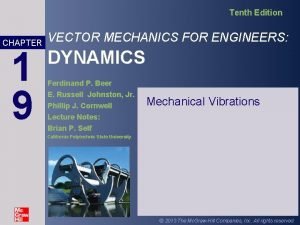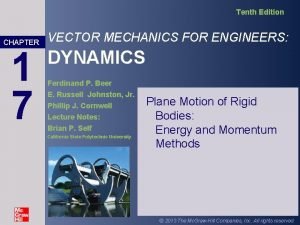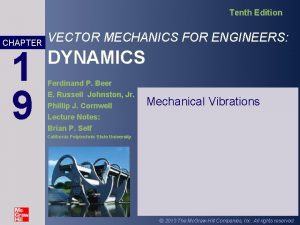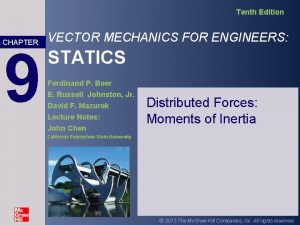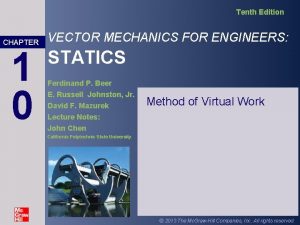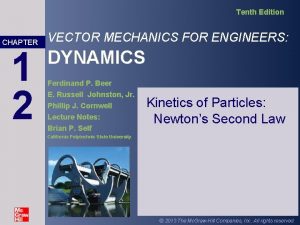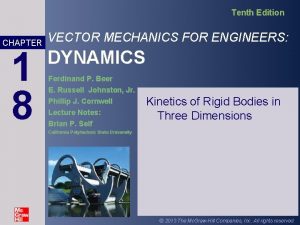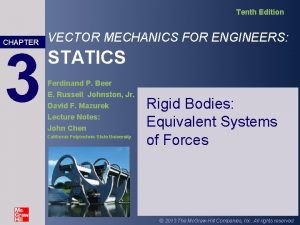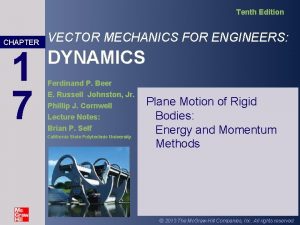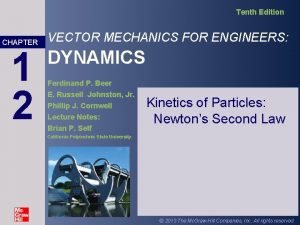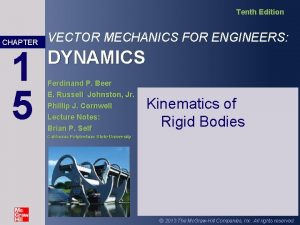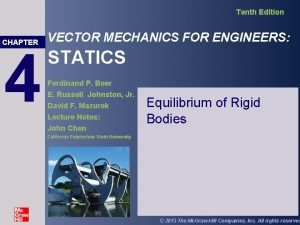Tenth Edition CHAPTER 1 4 VECTOR MECHANICS FOR







































- Slides: 39

Tenth Edition CHAPTER 1 4 VECTOR MECHANICS FOR ENGINEERS: DYNAMICS Ferdinand P. Beer E. Russell Johnston, Jr. Phillip J. Cornwell Systems of Particles Lecture Notes: Brian P. Self California Polytechnic State University © 2013 The Mc. Graw-Hill Companies, Inc. All rights reserved.

Tenth Edition Vector Mechanics for Engineers: Dynamics Contents Introduction Application of Newton’s Laws: Effective Forces Linear and Angular Momentum Motion of Mass Center of System of Particles Angular Momentum About Mass Center Conservation of Momentum Sample Problem 14. 2 Kinetic Energy Work-Energy Principle. Conservation of Energy Principle of Impulse and Momentum Sample Problem 14. 4 Sample Problem 14. 5 Variable Systems of Particles Steady Stream of Particles. Applications Streams Gaining or Losing Mass Sample Problem 14. 6 © 2013 The Mc. Graw-Hill Companies, Inc. All rights reserved. 14 - 2

Tenth Edition Vector Mechanics for Engineers: Dynamics Engineers often need to analyze the dynamics of systems of particles – this is the basis for many fluid dynamics applications, and will also help establish the principles used in analyzing rigid bodies © 2013 The Mc. Graw-Hill Companies, Inc. All rights reserved. 2 -3

Tenth Edition Vector Mechanics for Engineers: Dynamics Introduction • In the current chapter, you will study the motion of systems of particles. • The effective force of a particle is defined as the product of it mass and acceleration. It will be shown that the system of external forces acting on a system of particles is equipollent with the system of effective forces of the system. • The mass center of a system of particles will be defined and its motion described. • Application of the work-energy principle and the impulse -momentum principle to a system of particles will be described. Result obtained are also applicable to a system of rigidly connected particles, i. e. , a rigid body. • Analysis methods will be presented for variable systems of particles, i. e. , systems in which the particles included in the system change. © 2013 The Mc. Graw-Hill Companies, Inc. All rights reserved. 14 - 4

Tenth Edition Vector Mechanics for Engineers: Dynamics Application of Newton’s Laws. Effective Forces • Newton’s second law for each particle Pi in a system of n particles, • The system of external and internal forces on a particle is equivalent to the effective force of the particle. • The system of external and internal forces acting on the entire system of particles is equivalent to the system of effective forces. © 2013 The Mc. Graw-Hill Companies, Inc. All rights reserved. 14 - 5

Tenth Edition Vector Mechanics for Engineers: Dynamics Application of Newton’s Laws. Effective Forces • Summing over all the elements, • Since the internal forces occur in equal and opposite collinear pairs, the resultant force and couple due to the internal forces are zero, • The system of external forces and the system of effective forces are equipollent by not equivalent. © 2013 The Mc. Graw-Hill Companies, Inc. All rights reserved. 14 - 6

Tenth Edition Vector Mechanics for Engineers: Dynamics Linear & Angular Momentum • Linear momentum of the system of particles, • Resultant of the external forces is equal to rate of change of linear momentum of the system of particles, • Angular momentum about fixed point O of system of particles, • Moment resultant about fixed point O of the external forces is equal to the rate of change of angular momentum of the system of particles, © 2013 The Mc. Graw-Hill Companies, Inc. All rights reserved. 14 - 7

Tenth Edition Vector Mechanics for Engineers: Dynamics Motion of the Mass Center of a System of Particles • Mass center G of system of particles is defined by position vector which satisfies • Differentiating twice, • The mass center moves as if the entire mass and all of the external forces were concentrated at that point. © 2013 The Mc. Graw-Hill Companies, Inc. All rights reserved. 14 - 8

Tenth Edition Vector Mechanics for Engineers: Dynamics Angular Momentum About the Mass Center • The angular momentum of the system of particles about the mass center, • Consider the centroidal frame of reference Gx’y’z’, which translates with respect to the Newtonian frame Oxyz. • The centroidal frame is not, in general, a Newtonian frame. • The moment resultant about G of the external forces is equal to the rate of change of angular momentum about G of the system of particles. © 2013 The Mc. Graw-Hill Companies, Inc. All rights reserved. 14 - 9

Tenth Edition Vector Mechanics for Engineers: Dynamics Angular Momentum About the Mass Center • Angular momentum about G of particles in their absolute motion relative to the Newtonian Oxyz frame of reference. • Angular momentum about G of the particles in their motion relative to the centroidal Gx’y’z’ frame of reference, • Angular momentum about G of the particle momenta can be calculated with respect to either the Newtonian or centroidal frames of reference. © 2013 The Mc. Graw-Hill Companies, Inc. All rights reserved. 14 - 10

Tenth Edition Vector Mechanics for Engineers: Dynamics Conservation of Momentum • If no external forces act on the particles of a system, then the linear momentum and angular momentum about the fixed point O are conserved. • Concept of conservation of momentum also applies to the analysis of the mass center motion, • In some applications, such as problems involving central forces, © 2013 The Mc. Graw-Hill Companies, Inc. All rights reserved. 14 - 11

Tenth Edition Vector Mechanics for Engineers: Dynamics Concept Question Three small identical spheres A, B, and C, which can slide on a horizontal, frictionless surface, are attached to three 200 -mm-long strings, which are tied to a ring G. Initially, each of the spheres rotate clockwise about the ring with a relative velocity of vrel. Which of the following is true? a) b) c) d) vrel x vrel The linear momentum of the system is in the positive x direction The angular momentum of the system is in the positive y direction The angular momentum of the system about G is zero The linear momentum of the system is zero © 2013 The Mc. Graw-Hill Companies, Inc. All rights reserved. 2 - 12

Tenth Edition Vector Mechanics for Engineers: Dynamics Sample Problem 14. 2 SOLUTION: • Since there are no external forces, the linear momentum of the system is conserved. • Write separate component equations for the conservation of linear momentum. A 20 -lb projectile is moving with a velocity of 100 ft/s when it explodes into 5 and 15 -lb fragments. Immediately after the explosion, the fragments travel in the directions q. A = 45 o and q. B = 30 o. • Solve the equations simultaneously for the fragment velocities. Determine the velocity of each fragment. © 2013 The Mc. Graw-Hill Companies, Inc. All rights reserved. 14 - 13

Tenth Edition Vector Mechanics for Engineers: Dynamics Sample Problem 14. 2 SOLUTION: • Since there are no external forces, the linear momentum of the system is conserved. • Write separate component equations for the conservation of linear momentum. x components: y x • Solve the equations simultaneously for the fragment velocities. © 2013 The Mc. Graw-Hill Companies, Inc. All rights reserved. 14 - 14

Tenth Edition Vector Mechanics for Engineers: Dynamics Group Problem Solving v. A v 0 v. C v. B In a game of pool, ball A is moving with a velocity v 0 when it strikes balls B and C, which are at rest and aligned as shown. Knowing that after the collision the three balls move in the directions indicated and that v 0 = 12 ft/s and v. C= 6. 29 ft/s, determine the magnitude of the velocity of (a) ball A, (b) ball B. © 2013 The Mc. Graw-Hill Companies, Inc. All rights reserved. SOLUTION: • Since there are no external forces, the linear momentum of the system is conserved. • Write separate component equations for the conservation of linear momentum. • Solve the equations simultaneously for the pool ball velocities. 14 - 15

Tenth Edition Vector Mechanics for Engineers: Dynamics Group Problem Solving Write separate component equations for the conservation of linear momentum x: y: (1) (2) Two equations, two unknowns - solve 0. 65210 ( + 0. 75813 ( ) ) Sub into (1) or (2) to get v. B © 2013 The Mc. Graw-Hill Companies, Inc. All rights reserved. 14 - 16

Tenth Edition Vector Mechanics for Engineers: Dynamics Concept Question In a game of pool, ball A is moving with a velocity v 0 when it strikes balls B and C, which are at rest and aligned as shown. After the impact, what is true about the overall center of mass of the system of three balls? v. A v 0 v. C v. B a) The overall system CG will move in the same direction as v 0 b) The overall system CG will stay at a single, constant point c) There is not enough information to determine the CG location © 2013 The Mc. Graw-Hill Companies, Inc. All rights reserved. 14 - 17

Tenth Edition Vector Mechanics for Engineers: Dynamics Kinetic Energy • Kinetic energy of a system of particles, • Expressing the velocity in terms of the centroidal reference frame, • Kinetic energy is equal to kinetic energy of mass center plus kinetic energy relative to the centroidal frame. © 2013 The Mc. Graw-Hill Companies, Inc. All rights reserved. 14 - 18

Tenth Edition Vector Mechanics for Engineers: Dynamics Work-Energy Principle. Conservation of Energy • Principle of work and energy can be applied to each particle Pi , where represents the work done by the internal forces and the resultant external force acting on Pi. • Principle of work and energy can be applied to the entire system by adding the kinetic energies of all particles and considering the work done by all external and internal forces. • Although are equal and opposite, the work of these forces will not, in general, cancel out. • If the forces acting on the particles are conservative, the work is equal to the change in potential energy and which expresses the principle of conservation of energy for the system of particles. © 2013 The Mc. Graw-Hill Companies, Inc. All rights reserved. 14 - 19

Tenth Edition Vector Mechanics for Engineers: Dynamics Principle of Impulse and Momentum • The momenta of the particles at time t 1 and the impulse of the forces from t 1 to t 2 form a system of vectors equipollent to the system of momenta of the particles at time t 2. © 2013 The Mc. Graw-Hill Companies, Inc. All rights reserved. 14 - 20

Tenth Edition Vector Mechanics for Engineers: Dynamics Sample Problem 14. 4 SOLUTION: Ball B, of mass m. B, is suspended from a cord, of length l, attached to cart A, of mass m. A, which can roll freely on a frictionless horizontal tract. While the cart is at rest, the ball is given an initial velocity • With no external horizontal forces, it follows from the impulse-momentum principle that the horizontal component of momentum is conserved. This relation can be solved for the velocity of B at its maximum elevation. • The conservation of energy principle can be applied to relate the initial kinetic energy to the maximum potential energy. The maximum vertical distance is determined from this relation. Determine (a) the velocity of B as it reaches it maximum elevation, and (b) the maximum vertical distance h through which B will rise. © 2013 The Mc. Graw-Hill Companies, Inc. All rights reserved. 14 - 21

Tenth Edition Vector Mechanics for Engineers: Dynamics Sample Problem 14. 4 SOLUTION: • With no external horizontal forces, it follows from the impulse-momentum principle that the horizontal component of momentum is conserved. This relation can be solved for the velocity of B at its maximum elevation. y x component equation: x Velocities at positions 1 and 2 are (velocity of B relative to A is zero at position 2) © 2013 The Mc. Graw-Hill Companies, Inc. All rights reserved. 14 - 22

Tenth Edition Vector Mechanics for Engineers: Dynamics Sample Problem 14. 4 • The conservation of energy principle can be applied to relate the initial kinetic energy to the maximum potential energy. Position 1 - Potential Energy: Kinetic Energy: Position 2 - Potential Energy: Kinetic Energy: © 2013 The Mc. Graw-Hill Companies, Inc. All rights reserved. 14 - 23

Tenth Edition Vector Mechanics for Engineers: Dynamics Sample Problem 14. 5 SOLUTION: • There are four unknowns: v. A, v. B, x, v. B, y, and v. C. • Solution requires four equations: conservation principles for linear momentum (two component equations), angular momentum, and energy. Ball A has initial velocity v 0 = 10 ft/s parallel to the axis of the table. It hits ball B and then ball C which are both at rest. Balls A and C hit the sides of the table squarely at A’ and C’ and ball B hits obliquely at B’. • Write the conservation equations in terms of the unknown velocities and solve simultaneously. Assuming perfectly elastic collisions, determine velocities v. A, v. B, and v. C with which the balls hit the sides of the table. © 2013 The Mc. Graw-Hill Companies, Inc. All rights reserved. 14 - 24

Tenth Edition Vector Mechanics for Engineers: Dynamics Sample Problem 14. 5 SOLUTION: • There are four unknowns: v. A, v. B, x, v. B, y, and v. C. • The conservation of momentum and energy equations, Solving the first three equations in terms of v. C, Substituting into the energy equation, y x © 2013 The Mc. Graw-Hill Companies, Inc. All rights reserved. 14 - 25

Tenth Edition Vector Mechanics for Engineers: Dynamics Group Problem Solving Three small identical spheres A, B, and C, which can slide on a horizontal, frictionless surface, are attached to three 200 -mm-long strings, which are tied to a ring G. Initially, the spheres rotate clockwise about the ring with a relative velocity of 0. 8 m/s and the ring moves along the x-axis with a velocity v 0= (0. 4 m/s)i. Suddenly, the ring breaks and the three spheres move freely in the xy plane with A and B following paths parallel to the y-axis at a distance a= 346 mm from each other and C following a path parallel to the x axis. Determine (a) the velocity of each sphere, (b) the distance d. © 2013 The Mc. Graw-Hill Companies, Inc. All rights reserved. 14 - 26

Tenth Edition Vector Mechanics for Engineers: Dynamics Group Problem Solving Given: v. Arel= v. Brel = v. Crel = 0. 8 m/s, v 0= (0. 4 m/s)i , L= 200 mm, a= 346 mm Find: v. A, v. B, v. C (after ring breaks), d SOLUTION: • There are four unknowns: v. A, v. B, d. • Solution requires four equations: conservation principles for linear momentum (two component equations), angular momentum, and energy. • Write the conservation equations in terms of the unknown velocities and solve simultaneously. © 2013 The Mc. Graw-Hill Companies, Inc. All rights reserved. Apply the conservation of linear momentum equation – find L 0 before ring breaks What is Lf (after ring breaks)? 14 - 27

Tenth Edition Vector Mechanics for Engineers: Dynamics Group Problem Solving Set L 0= Lf x. A From the y components, From the x components, Apply the conservation of angular momentum equation H 0: H f: Since v. A= v. B, and v. C = 1. 2 m/s, then: © 2013 The Mc. Graw-Hill Companies, Inc. All rights reserved. 14 - 28

Tenth Edition ; Vector Mechanics for Engineers: Dynamics Group Problem Solving ; Need another equationtry work-energy, where T 0 = T f x. A T 0: T f: Substitute in known values: © 2013 The Mc. Graw-Hill Companies, Inc. All rights reserved. Solve for d: 14 - 29

Tenth Edition Vector Mechanics for Engineers: Dynamics Variable Systems of Particles • Kinetics principles established so far were derived for constant systems of particles, i. e. , systems which neither gain nor lose particles. • A large number of engineering applications require the consideration of variable systems of particles, e. g. , hydraulic turbine, rocket engine, etc. • For analyses, consider auxiliary systems which consist of the particles instantaneously within the system plus the particles that enter or leave the system during a short time interval. The auxiliary systems, thus defined, are constant systems of particles. © 2013 The Mc. Graw-Hill Companies, Inc. All rights reserved. 14 - 30

Tenth Edition Vector Mechanics for Engineers: Dynamics Steady Stream of Particles. Applications • Fan • Fluid Stream Diverted by Vane or Duct • Jet Engine • Helicopter © 2013 The Mc. Graw-Hill Companies, Inc. All rights reserved. 14 - 31

Tenth Edition Vector Mechanics for Engineers: Dynamics Steady Stream of Particles • System consists of a steady stream of particles against a vane or through a duct. • Define auxiliary system which includes particles which flow in and out over Dt. • The auxiliary system is a constant system of particles over Dt. © 2013 The Mc. Graw-Hill Companies, Inc. All rights reserved. 14 - 32

Tenth Edition Vector Mechanics for Engineers: Dynamics Streams Gaining or Losing Mass • Define auxiliary system to include particles of mass m within system at time t plus the particles of mass Dm which enter the system over time interval Dt. • The auxiliary system is a constant system of particles. © 2013 The Mc. Graw-Hill Companies, Inc. All rights reserved. 14 - 33

Tenth Edition Vector Mechanics for Engineers: Dynamics Sample Problem 14. 6 SOLUTION: • Define a system consisting of the mass of grain on the chute plus the mass that is added and removed during the time interval Dt. Grain falls onto a chute at the rate of 240 lb/s. It hits the chute with a velocity of 20 ft/s and leaves with a velocity of 15 ft/s. The combined weight of the chute and the grain it carries is 600 lb with the center of gravity at G. • Apply the principles of conservation of linear and angular momentum for three equations for the three unknown reactions. Determine the reactions at C and B. © 2013 The Mc. Graw-Hill Companies, Inc. All rights reserved. 14 - 34

Tenth Edition Vector Mechanics for Engineers: Dynamics Sample Problem 14. 6 SOLUTION: • Define a system consisting of the mass of grain on the chute plus the mass that is added and removed during the time interval Dt. • Apply the principles of conservation of linear and angular momentum for three equations for the three unknown reactions. Solve for Cx, Cy, and B with © 2013 The Mc. Graw-Hill Companies, Inc. All rights reserved. 14 - 35

Tenth Edition Vector Mechanics for Engineers: Dynamics Group Problem Solving SOLUTION: • Calculate the time rate of change of the mass of the air. • Determine thrust generated by the airstream. • Use this thrust to determine the maximum load that the helicopter can carry. The helicopter shown can produce a maximum downward air speed of 80 ft/s in a 30 -ft-diameter slipstream. Knowing that the weight of the helicopter and its crew is 3500 lb and assuming g= 0. 076 lb/ft 3 for air, determine the maximum load that the helicopter can lift while hovering in midair. © 2013 The Mc. Graw-Hill Companies, Inc. All rights reserved. 14 - 36

Tenth Edition Vector Mechanics for Engineers: Dynamics Group Problem Solving SOLUTION: Given: v. B = 80 ft/s, W= 3500 lbs, g= 0. 076 lb/ft 3 Find: Max load during hover Choose the relationship you will use to determine thrust Calculate the time rate of change (dm/dt) of the mass of the air. AB is the area of the slipstream v. B is the velocity in the slipstream. Well above the blade, v. A ≈ 0 © 2013 The Mc. Graw-Hill Companies, Inc. All rights reserved. 2 - 37

Tenth Edition Vector Mechanics for Engineers: Dynamics Group Problem Solving F Use the relationship for dm/dt to determine thrust WH W P Use statics to determine the maximum payload during hover W = 7180 lb © 2013 The Mc. Graw-Hill Companies, Inc. All rights reserved. 2 - 38

Tenth Edition Vector Mechanics for Engineers: Dynamics Concept Question In the previous problem with the maximum payload attached, what happens if the helicopter tilts (or pitches) forward? a) b) c) d) The area of displaced air becomes smaller The volume of displaced air becomes smaller The helicopter will accelerate upward The helicopter will accelerate forward *The helicopter will also accelerate downward © 2013 The Mc. Graw-Hill Companies, Inc. All rights reserved. 2 - 39
 Vector mechanics for engineers statics 10th edition
Vector mechanics for engineers statics 10th edition Vector mechanics for engineers statics 10th edition
Vector mechanics for engineers statics 10th edition Vector mechanics
Vector mechanics Vector mechanics for engineers statics 10th edition
Vector mechanics for engineers statics 10th edition Campbell biology tenth edition
Campbell biology tenth edition Campbell biology tenth edition
Campbell biology tenth edition Campbell biology tenth edition
Campbell biology tenth edition Elementary statistics tenth edition
Elementary statistics tenth edition Digital electronics by floyd
Digital electronics by floyd Corporate finance tenth edition
Corporate finance tenth edition Psychology tenth edition in modules
Psychology tenth edition in modules Introduction to genetic analysis tenth edition
Introduction to genetic analysis tenth edition Corporate finance tenth edition
Corporate finance tenth edition Corporate finance tenth edition
Corporate finance tenth edition Corporate finance tenth edition
Corporate finance tenth edition Corporate finance tenth edition
Corporate finance tenth edition Biology tenth edition
Biology tenth edition The graph shows data from the light colored soil
The graph shows data from the light colored soil Cloroplastos
Cloroplastos Biology tenth edition
Biology tenth edition Beer johnston
Beer johnston Mechanics of materials 6th edition solutions chapter 7
Mechanics of materials 6th edition solutions chapter 7 Mechanics of materials chapter 6
Mechanics of materials chapter 6 Mechanics of materials 6th edition solutions chapter 5
Mechanics of materials 6th edition solutions chapter 5 Mechanics of materials chapter 10 solutions pdf
Mechanics of materials chapter 10 solutions pdf Mechanics of materials chapter 4
Mechanics of materials chapter 4 Mechanic of materials
Mechanic of materials Mechanics
Mechanics Friction chapter in engineering mechanics
Friction chapter in engineering mechanics 2 force systems
2 force systems Vector mechanics for engineers
Vector mechanics for engineers Tenth chapter wired
Tenth chapter wired Fluid mechanics fundamentals and applications
Fluid mechanics fundamentals and applications Static equilibrium
Static equilibrium Chapter 2 force vectors
Chapter 2 force vectors What is line of action
What is line of action Vector mechanics for engineers
Vector mechanics for engineers Static mechanics
Static mechanics Vector mechanics
Vector mechanics Vector mechanics for engineers: dynamics
Vector mechanics for engineers: dynamics
